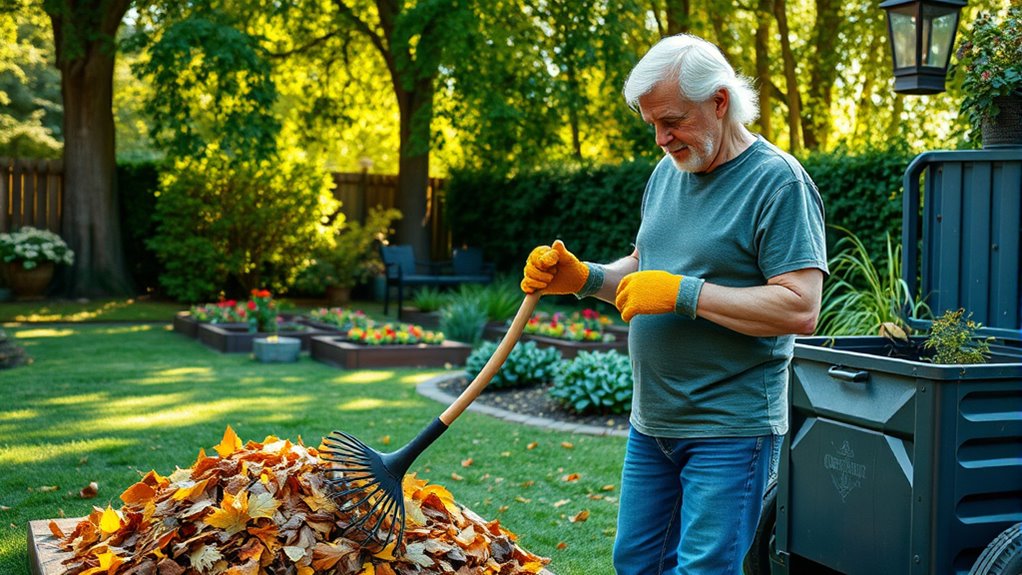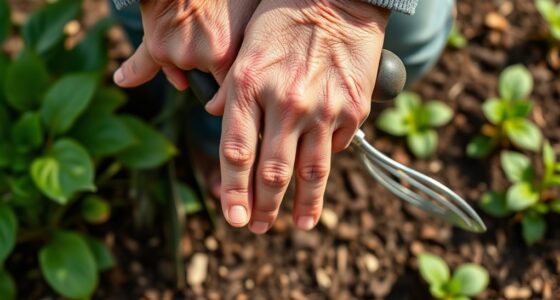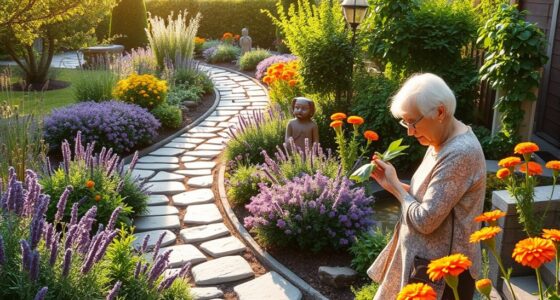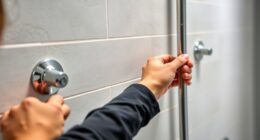To make yard work easier and safer, keep pathways clear of debris and use sturdy handrails on steps. Choose ergonomic, lightweight tools with padded handles to reduce strain and prevent fatigue. Use long-handled tools to avoid excessive bending, and wear footwear with good grip for stability. Take regular breaks, stay hydrated, and incorporate stretching routines. Proper organization and safety features can make gardening more manageable—continue exploring ways to enjoy safe, stress-free yard maintenance.
Key Takeaways
- Use ergonomic tools with padded grips and lightweight designs to reduce strain and effort.
- Keep pathways clear of debris and tripping hazards for safe navigation.
- Incorporate long-handled tools and adjustable equipment to minimize bending and reaching.
- Invest in supportive garden seats, kneelers, and safety handrails for comfort and stability.
- Take regular breaks, stay hydrated, and include stretching routines to prevent fatigue and injuries.

Maintaining a beautiful garden can be rewarding at any age, but it’s especially important for older gardeners to adopt strategies that make yard work safer and easier. One of the most effective ways to do this is by focusing on garden safety. You want to prevent falls, strains, and injuries, so start by clearing pathways of debris and tripping hazards. Keep your tools and equipment organized and within easy reach to avoid unnecessary bending or stretching. Installing sturdy handrails along steps and slopes can provide extra support, giving you confidence as you navigate your yard. Always wear appropriate footwear with good grip, and consider using knee pads or cushions to protect your joints when working close to the ground. Staying hydrated and taking regular breaks also help prevent fatigue and reduce the risk of accidents.
When it comes to tools, paying attention to tool ergonomics can make a big difference. Ergonomic tools are designed to fit comfortably in your hand and reduce strain on your wrists, elbows, and shoulders. Look for tools with padded handles or grips that conform to your hand’s shape, which can minimize discomfort during prolonged use. Lightweight tools are easier to maneuver and reduce fatigue, especially if you have joint issues or arthritis. Adjustable tools, such as telescoping pruners or extendable rakes, allow you to work without overreaching or bending excessively, keeping your movements natural and less stressful on your body. This focus on tool ergonomics helps you work more efficiently and reduces the risk of repetitive strain injuries. Additionally, selecting vetted dog products like comfortable, supportive dog beds can help keep your pet relaxed and safe while you tend to your garden. Incorporating attention to detail in your garden setup can also enhance safety and efficiency. Incorporating ergonomic garden tools can further prevent strain and improve your gardening experience. Using tools with ergonomic features can significantly decrease the physical effort required and help prevent discomfort over time.
To further enhance safety and ease, consider investing in ergonomic garden seats or kneelers with padding. These provide a comfortable way to reach low-growing plants or soil without putting undue pressure on your knees or back. When planting or weeding, use long-handled tools to stay upright and avoid bending over repeatedly. This not only minimizes back pain but also keeps your yard work manageable over longer periods. Incorporating proper stretching routines before and after gardening can also help prevent muscle strains and improve flexibility, making your gardening efforts more enjoyable. Remember, the goal is to adapt your gardening practices to your physical needs, which means taking the time to choose the right tools and safety features. By doing so, you’ll enjoy your gardening passion without risking injury or fatigue. With these simple adjustments, maintaining your garden becomes a safer, more enjoyable activity that can be sustained for years to come.
Frequently Asked Questions
What Are the Best Tools for Low-Effort Yard Work?
When tackling yard work, you want tools that make the job easier. Focus on garden tool ergonomics to reduce strain and increase comfort. Opt for lightweight gardening tools, which are easier to handle and less tiring. These tools help you work efficiently without overexerting yourself, making yard maintenance simpler and more enjoyable. With the right ergonomic and lightweight tools, you can keep your yard looking great with less effort.
How Can I Prevent Falls While Gardening?
They say, “An ounce of prevention is worth a pound of cure.” To prevent falls while gardening, you should watch out for slip hazards like wet leaves or uneven ground. Always wear sturdy shoes with good grip, use safety precautions like gloves and knee pads, and keep your workspace tidy. Taking these simple steps helps you enjoy gardening safely and reduces the risk of slips and falls.
Are There Easy-To-Maintain Plants for Shaded Areas?
You’ll find that shade-loving plants with low-maintenance foliage make gardening easier in shaded areas. Opt for varieties like hostas, ferns, or astilbes, which thrive with minimal care. These plants are resilient and adapt well to low light, reducing your workload. By choosing such easy-to-maintain plants, you can enjoy a lush, beautiful garden without the hassle of frequent pruning or special attention, keeping your gardening simple and enjoyable.
How Often Should I Water My Garden in Summer?
Think of your garden as a thirsty traveler in summer’s heat. You should water deeply about 2-3 times a week, adjusting for rainfall and drought considerations. A consistent watering schedule helps plants thrive, especially during dry spells. Early mornings or late evenings are best to reduce evaporation. Remember, overwatering can be just as harmful as drought, so keep an eye on soil moisture and adapt your routine accordingly.
What Safety Gear Is Recommended for Garden Tasks?
When tackling garden tasks, you should always wear safety gear to protect yourself. Always don protective gloves to guard against thorns, dirt, and potential irritants. Safety glasses are essential when using power tools or pruning to shield your eyes from debris. These precautions help prevent injuries, making your gardening safer and more enjoyable. Remember, taking a few simple safety steps keeps you healthy and ready for your next gardening session.
Conclusion
Taking care of your yard doesn’t have to be overwhelming. With simple tools and smart strategies, you can maintain a beautiful garden while easing physical strain. Remember, studies show that gardening boosts mental health and physical activity, especially for older adults. So, embrace these easy tips, stay active, and enjoy your outdoor space. Your well-maintained yard not only enhances your home’s appeal but also contributes to your overall well-being—making every moment spent outside truly worthwhile.









